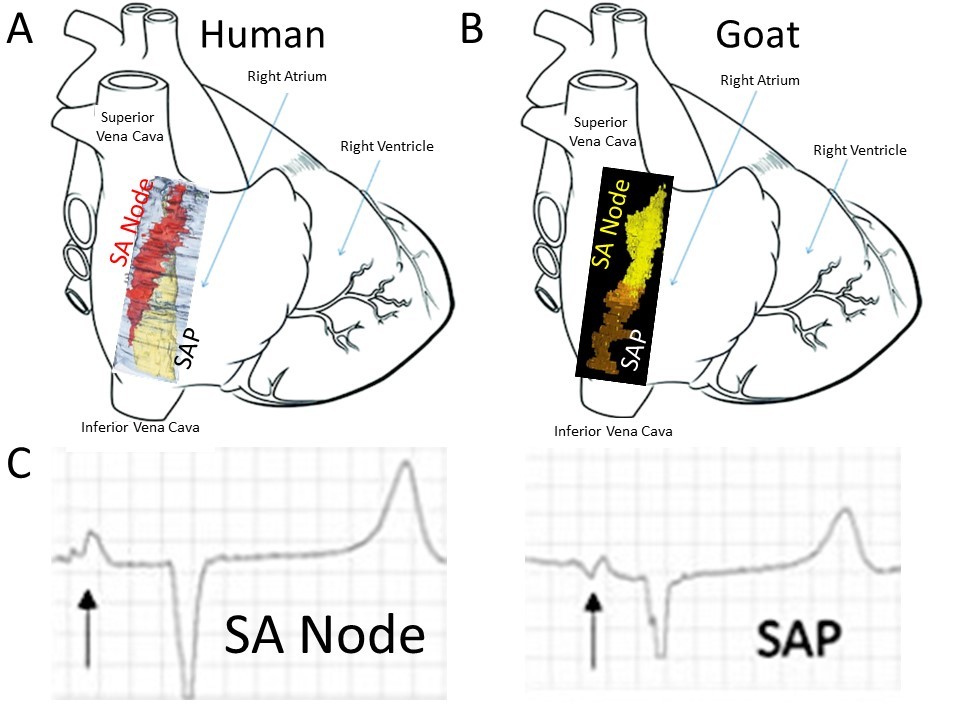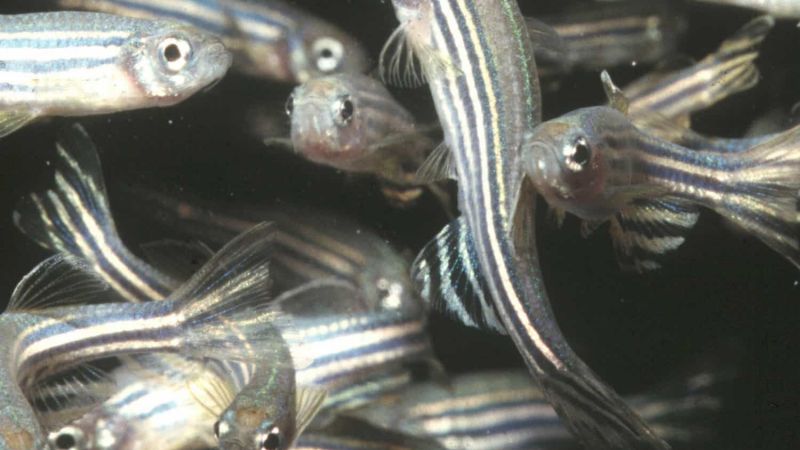
Researchers discover a backup natural pacemaker in the heart
Researchers from the University of Manchester, funded by the British Heart Foundation, have discovered a new structure in the hearts of goats that produces the electrical signals necessary to make the heart beat when the main electricity-producing cells – called the SA Node – fail.
This ‘natural pacemaker’ was identified in a study involving 15 goats. Goats were chosen because they have a similar anatomy and physiology and produce a similar heart beat to humans, giving researchers confidence that these results will be highly relevant to humans.
Lead author Dr Halina Dobrzynski, from The University of Manchester, said: “This study completely reshapes our understanding of the how the heart works and is tremendously exciting. It builds on our work on the human heart over many years and we hope will make an important contribution to future treatments.”
Read more: Researchers discover a backup natural pacemaker in the heart

Lifespan of mice doubles in low-oxygen environment
A recent study at Harvard Medical School found that mice kept in a low-oxygen environment lived for50% longer than expected.
“Epidemiological studies have hinted that populations that live at higher altitudes tend to live longer and stay healthier as they age. We wanted to test whether, in a more controlled setting, restricting oxygen appears to do the same in our mouse model of aging,” said study senior author Vamsi Mootha, professor of systems biology in the Blavatnik Institute at Harvard Medical School.
The study used mice that age abnormally fast, usually reaching 3–4 months in age before succumbing to age-related disease, unlike their wild counterparts that naturally live for around two years. Once weaned, the mice were moved to a hypoxic chamber that contained an oxygen concentration of just 11%. The fast-ageing mice kept at normal oxygen levels of 21% had a median lifespan of around 16 weeks, but the mice kept in a low-oxygen environment lived for a surprising 24 weeks on average, 50% longer than expected. The maximum lifespan of the mice also increased in the low-oxygen environment by around 30%, from 26 weeks to 31 weeks.
In addition to increased lifespan, the neurological function and cognition of mice kept in a low oxygen environment was preserved for longer and they performed better in standard tests of coordination and strength for longer. Also surprising to the authors of the study, mice in a low-oxygen environment ate slightly more food than those kept at conventional oxygen levels.
“A search for unusual gene activity, DNA damage, or changes in signalling pathways in the oxygen-restricted mice turned up some tantalizing clues but no definitive answers,” Says Robert Rogers, a postdoctoral researcher who worked on the study.
Future studies could expand the findings by examining whether oxygen restriction can similarly extend lifespan in wild-type mice, seeking to define what mechanisms might be responsible for the life-extending effects of restricted oxygen, and trying to determine whether those mechanisms affect all organs.
Read more: Decrease oxygen to boost longevity?
Researchers image adaptive immune systems at work in fish for the first time
For the first time, researchers have imaged the adaptive immune system of zebrafish. The study tracked the movement of immune cells throughout the zebrafish in exceptional detail. The stunning images produced show in detail the cells’ systematic circulation around the body.
Interestingly, the researchers did not initially set out to map the fishes’ immune system.
“It was very much unintentional,” said Tanner Robertson, a postdoctoral researcher in the Department of Medical Microbiology and Immunology who led the work. Unlike mammals, zebrafish (and many other animals) do not have a network of lymph nodes, the bean-shaped organs that play a key role in mammalian adaptive immune systems. Robertson set out to understand how an adaptive immune system could work in the absence of these apparently essential nodes. You can read more on this study and view the resulting images here: In a first, researchers image adaptive immune systems at work in fish
Read more: Researchers image adaptive immune systems at work in fish for the first time

Under a microscope, a 10-week-old zebrafish’s T cells (green) congregate along scale edges, forming a networked immune system across the animal’s body. For the first time, researchers at the University of Wisconsin–Madison have visualized the adaptive immune system of a non-mammal species in stunning detail. Tanner Robertson / University of Wisconsin–Madison


Image left: At the base of an adult zebrafish’s tail, called the caudal peduncle, the animal’s tessellated lymphoid network glows green against magenta-tinged scales. Tanner Robertson / University of Wisconsin–Madison
Image right: At the base of an adult zebrafish’s tail, the animal’s T cells glow green against the red of its blood vessels. Tanner Robertson / University of Wisconsin–Madison
Stem cell therapy trial greatly reduces epilepsy seizures in human subjects
The first two people to receive an experimental stem cell treatment for epilepsy have experienced a reduction in seizuresof more than 90% after a year of treatment. One patient had a more than 95% reduction in monthly seizures and did not have any seizures beyond the seventh month of the follow-up period. The patient also had improved memory scores on cognitive tests.
The therapy involves injecting a high concentration dose of inhibitory neurons (cells) into the brain. The neurons are grown in the laboratory using human embryonic stem cells.
Previous research in animals found that injected neurons were able to integrate with existing brain circuits and suppress seizures long-term. This research is now showing great promise in human clinical trials, offering hope that many sufferers from epilepsy will see their symptoms better controlled or even eliminated.
Read more: Stem cell therapy trial greatly reduces epilepsy seizures in human subjects
Taurine may extend life and health, scientists find
Taurine – a nutrient found in most animal products and also added as a supplement to items such as energy drinks – has been shown to extend the lifespan of various animal species. Taurine production tends to decline with age in most species, including humans.
Fourteen-month-old mice (considered middle-aged) that were given a daily dose of taurine lived, on average, 10% longer than control groups. The lifespan of male mice increased by 10% and female mice by 12%. Both sexes showed improved physical health compared to mice that were not given taurine supplements.
A study in worms found a similar increase in lifespan associated with taurine supplements, prolonging the worms’ life by 10–23%.
Fifteen-year-old rhesus macaque monkeys were also given a six-month course of taurine to assess the effects in primates. While the study did not go on long enough to assess whether taurine prolonged lifespan, scientists saw improvements in the animals’ body weight, bone density, blood-sugar levels, and immune system.
Although not yet tested directly in humans, researchers have carried out an analysis of 12,000 people and found that those with higher levels of taurine in their blood were generally healthier than people with low taurine.
“If the data from mice applied to people, it would be the equivalent of an extra seven to eight years of life,” Prof Henning Wackerhage, who was involved in the research at the Technical University of Munich. “But it will take proper clinical trials – where some people are given the nutrient and others a placebo pill – to see if any benefit can be detected.”
Read more: Taurine may extend life and health, scientists find
3Rs Prize winner announced
The National Centre for the 3Rs (NC3Rs) has awarded this year’s 3Rs prize to Dr Lisa Wagar for her entirely animal-free tonsil organoid model of respiratory infection and immunity. Using cells from human tissue samples, Dr Wagar developed miniature tonsils, known as organoids. Organoids are an exciting field of research that are already helping to reduce the number of animals used in scientific research.
Professor Kevin Shakesheff, Chair of the NC3Rs Board and 3Rs Prize Panel said: “The winning paper presents an elegant 3Rs solution to meet a significant and pressing need and I look forward to seeing the continued adoption of this replacement method in labs around the world.”
Read more: nc3rs.org.uk
Why are animal studies important in neuroscience research?
A new video from Science Animated talks about the use of animals in neuroscience and why monkeys are sometimes used in this type of research.
Last edited: 11 September 2023 15:47



